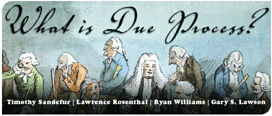Scientists who study evolution are sometimes challenged to produce the “missing link.” Those who have the patience to answer point out that there is no such thing as the missing link, and that to seek one is to misunderstand the basic idea of evolution. Indeed, as the old chestnut goes, every time you do find a link, it only opens up two more “gaps”! Evolution isn’t a bunch of links—it’s a process, a natural phenomenon, and we can comprehend and illustrate it by reference to specific fossils, but it is not to be found in any specific fossil. It is, so to speak, the line that connects the dots, and you just can’t draw a line by accumulating dots. To see a line—to understand evolution—we must engage in a process of abstraction, so that we grasp a general principle, which we can then test against the facts we have.
It seems this same “missing link” problem is often present in originalism discourse. Any particular piece of evidence from the founding era—for example, James Madison’s speech when introducing the Bill of Rights in the First Congress—is only one little fossil, and in isolation it tells us only so much. But if we take it and other “fossils”—say, James Wilson’s remarks at the Philadelphia ratification convention, Hamilton’s Federalist 84, and the correspondence between Madison and Jefferson about a Bill of Rights—then we can draw a line: we can put together a conceptual-level picture, a theoretical construct, of the theory of rights that the Constitution’s authors had in mind. Lord Coke, in a passage I quoted earlier, called this process grasping the “artificial perfection of reason” that is the law. It allows us to better understand, say, the Ninth Amendment’s reference to “other rights,” and, indeed, to understand more broadly what Randy Barnett has recently called the “presumption of liberty.” Yet some critics attacked Barnett, as they do me, by saying that he was only making an abstract philosophical argument; these critics demanded something like a “missing link”—some document that will say “Here’s exactly what we meant by the Ninth Amendment.” Any time we do offer up a fossil of originalism to show how it fits into our approach, we’re told it only opens two new gaps.
I think Prof. Rosenthal does something very like this. For example, he asks why Chief Justice Marshall didn’t cite the Fifth Amendment in Marbury v. Madison. Marshall is, of course, notorious for the paucity of citations in his decisions—Fletcher, Dartmouth College, and many of his other great rulings cite virtually no authority for anything; instead, they proceed irresistibly through logical argument from premises to conclusion, and are not the less ironclad for that.
But anyone who reads section two of Marbury—where Marshall addresses whether the law affords a remedy for Marbury’s injury—will find that it’s based profoundly on the theory I’ve advanced here. Marshall says that, except in special cases, an injured person is entitled to a remedy when he has been harmed by a lawless, unauthorized, arbitrary government action. If Marshall had believed, as Prof. Rosenthal does, that whatever government chooses to do according to rules of promulgation is automatically law, then it’s hard to imagine how he could have concluded either that Mr. Marbury was wrongfully deprived of his commission or that the Judiciary Act was unconstitutional. Searching for the “missing link” would make us miss the crucial point about one of the most important of all constitutional precedents: the principle that the government is not above the law—that unauthorized government acts are not law—and that, if the Court had jurisdiction, this would have entitled Marbury to the writ he sought. To regard Marbury as not fitting the model I’ve presented because it doesn’t cite the Fifth Amendment seems to me like arguing that “Oh Captain! My Captain!” isn’t about Lincoln because Whitman doesn’t use his name, or that Fanny Hill isn’t pornographic because it contains no profanity. It is, in short, formalism: it is “mechanical jurisprudence,” and, I think, it misconceives the process of legal reasoning.
Obviously I take the founders and their writings very seriously, and I’ve tried hard to provide good fossil specimens from their work to buttress my interpretation of the Constitution’s promise that government will act in a lawful, non-arbitrary manner. But in the end, we cannot look for a “missing link”: we must instead use the evidence to comprehend the broader picture suggested to us by these documents—a picture that is written in abstract principles, applicable to all men and all times.

